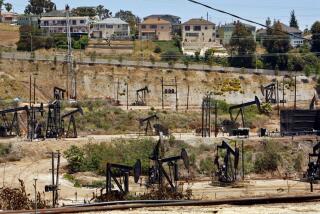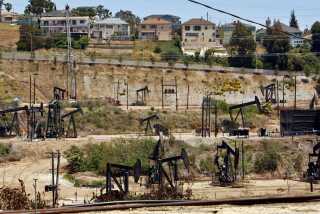THE MIDEAST CRISIS: ASSESSING THE DAMAGE : The Oil Patch : Cities Hurt by Energy Slump Hopeful Again
DENVER — The Iraqi invasion of Kuwait may have provoked fears of a recession for most Americans, but in Denver and other U.S. cities where the oil industry has been in a deep slump since the mid-1980s, the subsequent jump in oil prices was cause for cautious optimism.
In Colorado, Texas, Oklahoma and other petroleum-producing states, analysts said the price rise could help sagging regional economies rebound from years of stagnation--but only if oil continues to sell for $25 a barrel for a year or longer.
“If it continues for a long-term period, our economy will benefit at the expense of other parts of the nation,” said Nancy McCallin, chief economist with the Colorado Legislative Council, a research arm for the legislature.
In Denver, the decline in local oil production is blamed, among other things, for a slumping real estate market and construction industry. The city has a 23% vacancy rate in office space, mostly in the gleaming downtown towers built to house Texaco, Exxon and other companies that worked the Colorado oil fields.
The glut of cheap oil in the ‘80s has had an even more severe impact in Texas, where annual oil production declined from nearly 1.3 billion barrels during the Arab oil embargo in 1973 to only 762 million barrels in 1988.
At one point, housing values in Houston fell by 30% or more as those who settled in the region during the good times left in droves.
Now, four years after hitting the bottom of the slump in 1986, some parts of the Oil Patch have made a comeback. And some regions stand to benefit more from higher oil prices than others, analysts said.
In recent years, Houston and Dallas have developed more diversified economies that are less dependent on the whims of the international petroleum market. High-technology industries have played an important role in the economic recovery of Texas’ two largest cities.
Stephen Brown, senior economist at the Dallas Federal Reserve Bank, estimates that every $1 increase in the price of oil could add 15,000 jobs in Texas, 40% of them in the oil industry and the rest in retailing, service and other industries. So if oil hovers at $22 a barrel, Brown predicts 50,000 new jobs in Texas, which represents less than a 1% increase in employment in the state over the next two years.
“The increase (in oil prices) will help some, but we’re really not talking about very much here. Even at $25 a barrel, it isn’t very exciting,” he said. The energy industry represents only 10% of the gross state product, compared to 20% in 1981, he said.
But in Louisiana and the West Texas cities of Midland and Odessa, a sustained period of high oil prices would be a desperately needed boost to the local economies.
“(Midland-Odessa) is still largely energy-dependent. Clearly, the thing that would bring that area back is energy,” said Ralph Carestio, vice president for real estate and energy with NCNB, a Dallas bank. “If this isn’t just a short-term spike, it’s good news for the Texas economy and for domestic producers in general.”
John Faulkinberry, chief financial officer of Paramount Petroleum Co., a four-year-old Houston-based independent oil producer, said: “We hate to see a war key this chain of events, but we’ve all been smiling. We’re steaming right ahead.” Faulkinberry said Paramount drilled 22 wells in 1989 and is planning to drill 45 in 1990.
Still, despite a $5 increase in oil prices the past week, officials in Colorado and Texas said they are unwilling to link the future of their regional economies to what they see as an inherently volatile and unstable situation in the Middle East.
“It’s too uncertain right now,” added McCallin, the Colorado economist. “I can’t imagine that you’re going to see any large oil producers saying it makes more sense to drill in Colorado right now.”
Indeed, few in the oil industry were willing to predict an increase in domestic drilling any time soon.
“You’ll see a lot of companies that are gun-shy. After coming off this depression, they’re going to wait and see what happens,” Faulkinberry said.
“It’s far too early to say this is going to mean anything wonderful for domestic production,” said Jere Smith, a spokesman for Phillips Petroleum Co. in Bartlesville, Okla. “You can’t base your capital spending on one week of price increases.”
Smith added that Phillips is more likely to initiate new drilling abroad than it is domestically.
Bernard Weinstein, an economist at the University of North Texas, said he believed oil prices would have to stay in the mid-20s for at least three months before the oil industry would consider stepping up domestic production.
And, Weinstein added, it could be from one to three years before an overall improvement in the Texas economy could be felt.
“On balance, Texas stands more to gain than lose in higher prices,” Weinstein said. If $25-per-barrel oil sticks, Weinstein said $8 billion will be added to the gross state product over the next year, creating 64,000 new jobs and $258 million in state and local tax revenue.
While oil is “not the dominant industry it once was in Texas, higher energy prices will give our oil and gas sector a shot in the arm that it needs,” he said.
Small and independent producers fueled much of the Texas oil boom in the ‘70s and ‘80s. Many of those companies went under when crude prices sunk to $10 per barrel in 1986. Even as oil pushed toward $30 per barrel this week, most independents were sounding a word of caution.
“There’s a lot of uncertainty involved in all of this,” said Don Covey, president of the exploration and production division of Houston-based Mitchell Energy & Development Co. “We’ve just been in this a few days, and we don’t know how long it’s going to last. It’s going to take time to see how it shakes out.”
Times researchers Lianne Hart in Houston and Ann Rovin in Denver contributed to this story.
More to Read
Sign up for Essential California
The most important California stories and recommendations in your inbox every morning.
You may occasionally receive promotional content from the Los Angeles Times.











